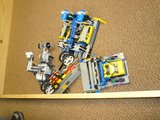|
The Arena
The Original! In this battle, we use our non patented
PAS to enclose the bots in a ring of terror! Currently, there are no official
rules. We put the bots in and let them battle. Once most of the bots are
incapacitated, we restart the battle.
Advantages: Fun, and quick bots can
be made
Disadvantages: Not always a clear winner, Not much intelligence
needed in the programs.
The Table
The first table battle will be in January... In this
battle, the objective is to be the last bot on the table moving.
Advantages: Clear winner
Disadvantages: Probably not as much carnage.
Team Arena
Same as arena, but 2 people work together building a
bot. This has not been done yet.
Advantages: More complex bots, with more
offensive capabilities
Disadvantages: Less bots
Team Table
Same as table, but 2 people work together building a
bot This has not been done yet.
Advantages: More complex bots, more sensory
perception
Disadvantages: Less bots, etc. etc.
One Day
People without Lego Mindstorm (tm) sets meet on a day off
and build bots in a couple of hours, program them (probably basic programs
supplied) and battle it out.
Advantages: This gives new people the
opportunity to give Battle Bricks a try before shelling out $200.
Disadvantages: More organization is involved, and a day off.
Head-On (Thanks Gregg!)
Two bots compete in a long narrow trench.
Each bot starts at opposite ends of the trench. The objective is to be the first
bot to reach the other bot's starting point.
Alternate Scoring method for a Head-On tournament (Thanks Tom!)
-1 point for the first bot to cross the mid point of the play area
(Trench, plank, whatever)
-2 points for the first bot to reach the
opposite end of the play area
Fortress (Thanks Gregg!)
Team competition. One team of bots
designs a defense line (of possible stationary bots). The other team must design
bots to penetrate the defensive line.
Suspended Head-On (Thanks Tom!)
Similar to "Head-On" except that
the two bots compete on a long narrow, suspended, plank. At the start of a
match no part of the bot may be located below the level of the top surface of
the plank. Optional limitation, (which is implicitly in the trench
competition)at the start of a match, the bot must be no wider than the plank
Zip Line Battle (Thanks Gordon!)
2 parallel zip lines with one bot each. The bots joust until one is
knocked off!
Joust
This is a modified head-on, where the object is not to reach the other side, but
ram into your opponent in an attempt to disable them. Disabling can be either by
damage sustained or by flipping the opponent. This is basically a demolition
derby in order to determine who can sustain the most punishment.
Not-So-Destructive-Competitions
SoccerBots
Attack Soccer! Rules are just like real soccer except there are no yellow cards. Played on
a field the size of a ping pong table using a ping pong ball, 'bots can be no larger than an 8 1/2" x 11" sheet of
paper. More information coming soon!
Flagbot (Thanks Bill!)
A variation on arena combat, where each bot must carry a flag (flag construction and
method of attachment specified in advance, and must be the same for all bots) on its topmost
surface. The last bot with its flag still attached wins. Disadvantage: may be hard to specify a
flag and an attachment method which will work for all bots; will give 'bot lawyers' a field day.
Bridgebot (Thanks Bill!)
Bots compete to cross a 'ditch'. The ditch gets progressively wider (and deeper?)
in successive rounds of competition; the last bot to successfully cross wins. No part of the bot
may remain on the 'near' side of the ditch, but the entire bot must begin on the near side.
Disadvantages: some bot-lawyering possibilities, maybe not too exciting.
Climbbot (Thanks Bill!)
Similar idea to Bridgebot, but now with a progressively higher 'cliff'.
Bombbot (Thanks Bill!)
Bots compete to drop some specified object as close to a target as possible.
IROCbot (Thanks Bill!)
Mechanically identical bots are built from a specification. Only RIS 1.0 or 1.5
parts are permitted. Contestants compete only by doing custom programming. Any of the competition
types would work.
Dumbbot (Thanks Bill!)
The reverse of IROCbot: a standard program must be used, but any mechanical design
is allowed. Hmmmmm.
Mazebot (Thanks Bill!)
Bots compete to run a simple maze. The width of the maze passages is specified in
advance. Each bot gets two (or more) runs through the maze. Time to complete maze is weighted
higher for later runs, to give an advantage to bots programmed to ''learn" the maze. Overall maze
complexity must be constrained to permit 'learning' behavior to be programmable within RCX
limitations.
Racebot (Thanks Bill!)
Bots compete for the fastest time to run around a course which is delimited by lines
drawn on a large paper racecourse, or alternatively by walls (but specified in advance of course).
Bots which don't stay in their lane (more or less) are disqualified. Multiple laps should be used.
IRBot (Thanks Bill!)
Bots have to cooperate to achieve some task, and use their IR ports to talk to each
other. This may be difficult to do.
Towerbot (Thanks Bill!)
Bots compete to build the highest possible tower out of some pre-specified brick
type, e.g., 2x4 Brick. Hmmmm.
Other Ideas? e-mail us at wgorman@gmail.com
| 


